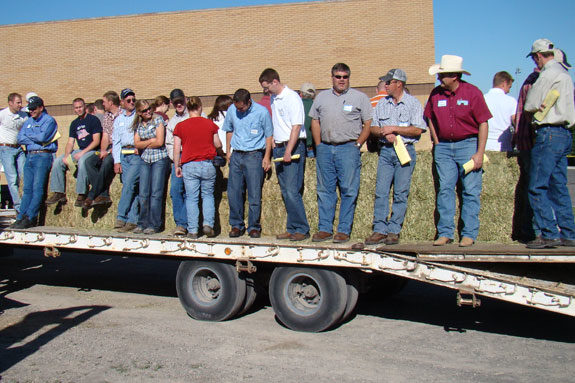Brigham Young University-Idaho held its annual Small Grains and Forages Field Day July 8, 2010.
The field day showcased research that is being done on the school’s farm to develop farming methods and plant varieties that apply in southeastern Idaho.
“I think the day went very well,” says Greg Blaser, a faculty member at BYU-Idaho. “A lot of people came. A lot of them were students, a lot of them were producers. There were about 100 people that were here.”
The event began with a brief introduction before everyone climbed onto trailers loaded with hay bales to visit different research sites on the farm.
The sites were introduced to the crowd by the researchers or their interns and included things such as alfalfa genetics, roundup-ready crops and an orchardgrass breeding program.
Dr. Peter Reisen, the director of alfalfa breeding at Forage Genetics International in Nampa, Idaho, presented some breeding and experimental plots of alfalfa that he has been working on.
“I’d say my favorite presentation was the forage genetics on the main plots,” says Aaron Firth, a sophomore at BYU-Idaho who works as the student farm manager, “just the information that was given on roundup ready hay, and also the different varieties of hay and ways to increase yield.”

Reisen’s current plots are in their second year, although he has been doing this work for the past six years. In the previous trials that he worked, he planted fall dormancy 3, 4 and 5 alfalfa, expecting that fall dormancy 5 was the best they could do because of the harsh winters.
But surprisingly, after five years, the fall dormancy 5 plants proved to have a better yield than any of the others. So in some of the current plots he planted a fall dormancy 6 variety, which so far has not performed as well as the fall dormancy 5. Reisen says they are working on improving the winter survival of that variety.
“Rexburg is a real important location, because we wouldn’t want to develop a variety exclusively on our data in Nampa where we are taking a five harvest, and sometimes a six harvest, system and expect it to perform the same up here in eastern Idaho, where you are under a three cut, and sometimes a four cut system,” Reisen says.
Reisen also presented his round-up ready alfalfa trials, explaining the recent events that occurred between the Supreme Court and the USDA. He and others are working on new traits in alfalfa, such as reduced lignin.
Reduced lignin alfalfa would be able to grow another week to ten days without losing digestibility. This would increase yield and reduce compaction and plant damage from harvesting equipment. They are hoping to have it out on the market in about seven years.
“The trials we have been putting in have been a real useful asset, both from evaluation and from selection, because we do go into them after four or five years and make selections so we know that new varieties are well adapted to the Rexburg area,” Reisen says.

A BYU-Idaho student, Cody Searle, presented an alfalfa irrigation study that he had been helping with as an intern. The study compared amounts of irrigation applied on the plots with the yield they produced. This is the first year of the two-year study.
“If we had a drought, and I was wanting to know how much can I cut back the water on my alfalfa before the yield is really going to get damaged, this would help you know how much tonnage you were going to get off your alfalfa if you had to cut your water by 10 percent, we’ll say.
And if you cut your water by 10 percent, you’d lose about 5 percent of your yield. But the water that you didn’t have to irrigate on your alfalfa, you could use on your other crops, like cash crops,” Searle says.
Searle says he irrigates these plots based on the amount of evapotranspiration (ET), or evaporation from the soil and transpiration through the leaves, that occurs every day. He used a deficit irrigation formula to find how many inches of water alfalfa needs in the Rexburg area.
Every day he gets online and visits a website called Agrimet, where he finds how much ET has occurred that day. He irrigates his plots when the alfalfa has lost almost as much water as the amount it needs.
“The day went really well,” Firth says. “The biggest thing I took away from this is there’s still progression in agriculture, and there’s a lot of hope for the future.
With the new technologies and the new things that they’ve developed, there’s a lot more potential for crop production and being able to feed the world.” FG
PHOTOS
TOP: Attendees climb on a trailer to begin the tour.
MIDDLE: Greg Blaser introduces the field day and tells the crowd what they are going to do.
BOTTOM: Cody Searle presents his irrigation experiment.









